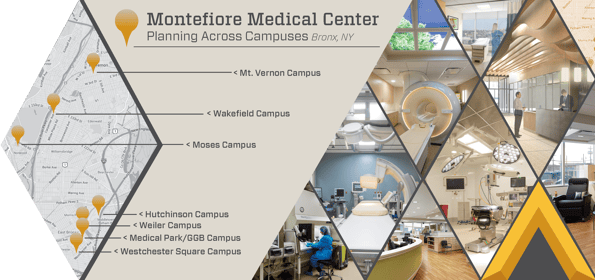As healthcare systems continue to expand and evolve, a new challenge has emerged. Facilities, whether newly built or newly acquired, are bringing additional resources into the system. These new service offerings need to fit into the existing hospital puzzle known as the health system. How does a health system go about this challenge? How do they account for these added operations and remain efficient while simultaneously elevating patient satisfaction? Furthermore, how do they do this effectively while knowing that another system change can be right around the corner?
Planning Across Campuses
Montefiore Medical Center, a system in the Bronx NY, has 1,930 beds across six hospitals and seems to have figured out successful innovative approaches to scaling their business to accommodate growth. An example of an integrated health delivery system that excels in the balancing act of increasing market share while doing what’s necessary to create a more comprehensive network and reducing waste, they have focused their strategy around the communities they serve, while also achieving business and clinical goals. Their continued expansion has generated the need for consolidation and right-sizing spaces.

Continuing to add health facilities system-wide requires planning across campuses and taking advantage of economies of scale. Array Architects’ partnership with Montefiore since early 2011 positioned us to be a trusted advisor, using our multi-campus knowledge to help the client make informed decisions not only about one particular building, but also the system as a whole. We were then able to assist with restructuring the facilities’ operations.
Our 35+ significant planning and design initiatives, master plans and feasibility studies, helped Array understand where our clients are heading in the future, as well as their strategic vision. As Montefiore Medical Center (Montefiore) continues on their path to optimize service line breadth, add specialties and centers of excellence, and expand their ambulatory care reach, cost reduction strategies and service line consolidation considerations come into the equation.
To Centralize, or Not to Centralize
Large healthcare organizations that are actively merging with and/or acquiring facilities and building new ground-up facilities for better healthcare offerings need to consider overall performance objectives and determine ways to optimize their operations. Improving quality and reducing cost through a greater standardization of care sometimes requires the centralization of services but other times calls for de-centralization.
Centralization
Hutch Campus: As Montefiore expands, their goal is to provide a centralized system of care that increases patient access and availability of healthcare services. This led them to embark on an ambulatory care venture. Array provided planning and design services for the complete fit out of building a new 278,000sf, 12-story facility. This building will serve as the ambulatory hub of the system.
When shifting from an inpatient care to an ambulatory care setting, Montefiore leveraged a high-tech building to accommodate imaging and surgical services that can also house primary care and multi-specialty physicians. Ambulatory care center designs are typically flexible and adaptable, as well as allow for future growth, so a project like this absolutely made sense. Bringing all of the clinicians together from various campuses into a centralized ambulatory care facility allowed for more coordinated care, helping the center achieve many system-wide goals:
- Provide services needed to support population health management
- Enable the ability to expand their primary care and specialty base
- Accommodate their rise in surgical procedures
- Ability to decant where minimally-invasive surgeries are happening within the facilities, producing more space for high acuity surgeries
- Prevent patients from experiencing long wait times
- House all clinicians under one roof for better info-sharing and collaboration
- Provide easy highway and mass transit access for patients coming from Manhattan, Long Island, Westchester and the Bronx
Mount Vernon Campus: Montefiore retained Array to work on another project with the goal of centralizing staff and services to one location to furnish greater expertise, collaboration and interaction. We strategized with the client to consolidate Pathology laboratory functions in an off-site facility to accommodate the changing industry, technology developments and their expansion plan. The system will consider this Center for Diagnostic Medicine (CDM) as part of the Mount Vernon campus, though it is a separate, off-site facility, formerly a four-level warehouse. The system’s goal was to offer a 24/7 reference lab, and to consolidate lab functions from all campuses into one location, enabling them to:
- Canvas space at all campuses for more hospital-based functions
- Use staffing more effectively and efficiently
- Foster a more collaborative, organized lab environment where people can work together in a more functional manner
- Provide knowledge-sharing
- Advance patient care, teaching, training, and clinical and translational research to accelerate the pace at which new discoveries become treatments and therapies to benefit patients
Moses Campus: Array worked with the Montefiore Medical Center Neurosciences Services Steering Committee to develop a focused, facilities master plan to define locations for the neuroscience services expansion, as well as to establish a roadmap for the creation of an identifiable Neuroscience Institute on the Moses Campus. A key planning goal was to reinforce the health system’s regional approach to Neuroscience care, ultimately improving the patient experience and outcomes using a comprehensive center of care. Array created concepts consolidating neurology inpatient units and establishing a dedicated Neurology Intensive Care Unit and Step Down Unit to improve connectivity.
Wakefield Campus: After purchasing this campus 4-5 years ago, Montefiore transformed it into a more holistic facility. In response to increased volume for joint surgeries and replacements, they decided to renovate existing Medical/Surgical units into a Joint Rehab Center. Array provided professional services to renovate the space to accommodate the decreased mobility of patients before and after surgery. Moving rehab spaces from multiple campuses, particularly from Weiler, makes the Wakefield Campus the best location to perform more intense orthopedic surgeries requiring recovery space. This decanting of rehab space to one location triggered the need to expand existing ORs and add new ORs, causing a relocation of emergency services as well.
It is important that a healthcare system have the proper vision when realigning their service lines or campuses due to additional service lines or acquisitions. Utilizing a centralized approach allows for a single location of a specific service line, therefore reducing cost with standardization while increasing quality and focus.
Please keep an eye out for my next blog post, where I discuss the benefits of de-centralization.
Blog written by Jason Lee, former Principal and Studio Director with Array.

